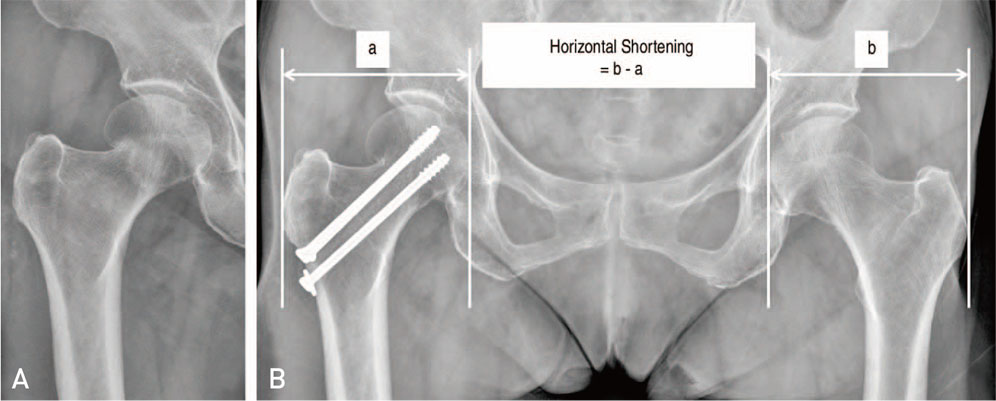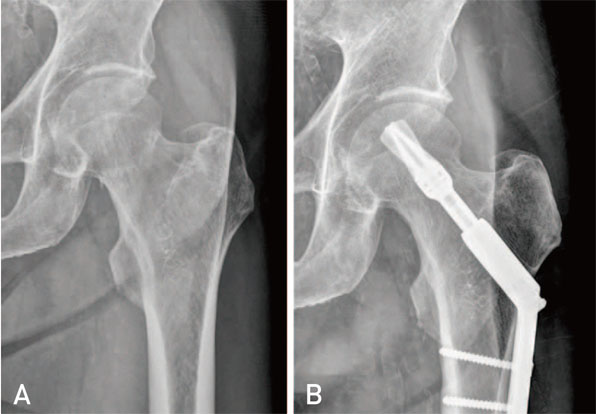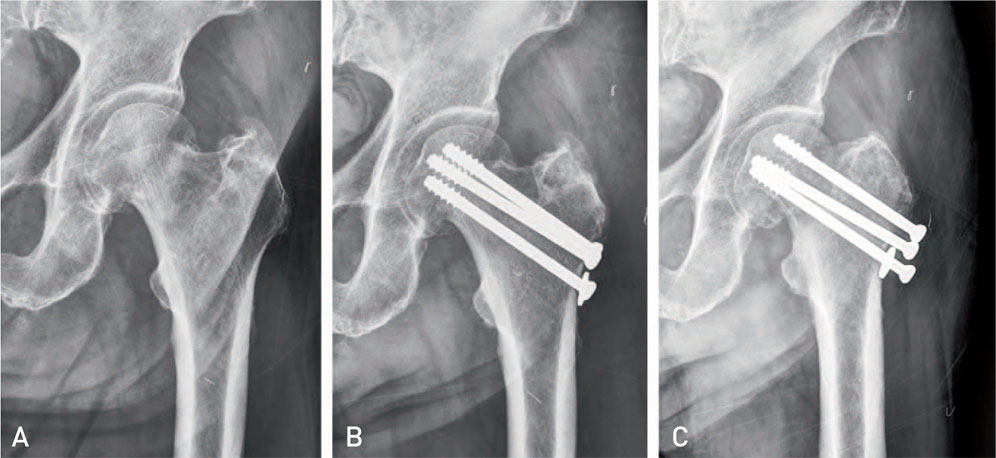Hip Pelvis.
2016 Mar;28(1):43-48. 10.5371/hp.2016.28.1.43.
Result of Internal Fixation for Stable Femoral Neck Fractures in Elderly Patients
- Affiliations
-
- 1Department of Orthopedic Surgery, Keimyung University School of Medicine, Daegu, Korea. oslee@dsmc.or.kr
- KMID: 2161314
- DOI: http://doi.org/10.5371/hp.2016.28.1.43
Abstract
- PURPOSE
This study was conducted to evaluate the results of internal fixation for stable femoral neck fractures occurring in patients over 65 years old.
MATERIALS AND METHODS
Between 2008 and 2014, we evaluated 25 patients over 65 years old with Garden type 1 and 2 femoral neck fractures that were treated with internal fixation after a minimum follow up of 1 year. There were 5 males and 20 females and the average age was 72.3 years (range, 65-84 years) at the time of surgery. Fracture site union, horizontal shortening and complications were evaluated as radiographic parameters and change of walking ability (as measured using Koval walking ability score) was investigated as a clinical parameter.
RESULTS
Union of fracture site was achieved in 24 out of the 25 cases (96.0%). The average length of horizontal shortening was 6.5 mm (range, 0.2-19.7 mm). At final follow up, 3 cases experienced complications: nonunion (n=1), avascular necrosis (n=1), and subtrochanteric fracture after minor trauma (n=1). Walking ability decreased an average of 1 step at the final follow up.
CONCLUSION
Internal fixation for stable femoral neck fractures occurring in patients over 65 years showed satisfactory union rates. However, care should be taken with this technique given the possibility of decreased walking ability resulting from horizontal shortening.
Keyword
MeSH Terms
Figure
Reference
-
1. Holt G, Smith R, Duncan K, Finlayson DF, Gregori A. Early mortality after surgical fixation of hip fractures in the elderly: an analysis of data from the scottish hip fracture audit. J Bone Joint Surg Br. 2008; 90:1357–1363.2. Sikand M, Wenn R, Moran CG. Mortality following surgery for undisplaced intracapsular hip fractures. Injury. 2004; 35:1015–1019.
Article3. Shah AK, Eissler J, Radomisli T. Algorithms for the treatment of femoral neck fractures. Clin Orthop Relat Res. 2002; (399):28–34.
Article4. Waaler Bjørnelv GM, Frihagen F, Madsen JE, Nordsletten L, Aas E. Hemiarthroplasty compared to internal fixation with percutaneous cannulated screws as treatment of displaced femoral neck fractures in the elderly: cost-utility analysis performed alongside a randomized, controlled trial. Osteoporos Int. 2012; 23:1711–1719.
Article5. Gjertsen JE, Vinje T, Engesaeter LB, et al. Internal screw fixation compared with bipolar hemiarthroplasty for treatment of displaced femoral neck fractures in elderly patients. J Bone Joint Surg Am. 2010; 92:619–628.
Article6. Leighton RK, Schmidt AH, Collier P, Trask K. Advances in the treatment of intracapsular hip fractures in the elderly. Injury. 2007; 38:Suppl 3. S24–S34.
Article7. Bhandari M, Devereaux PJ, Tornetta P 3rd, et al. Operative management of displaced femoral neck fractures in elderly patients. An international survey. J Bone Joint Surg Am. 2005; 87:2122–2130.
Article8. Sendtner E, Renkawitz T, Kramny P, Wenzl M, Grifka J. Fractured neck of femur--internal fixation versus arthroplasty. Dtsch Arztebl Int. 2010; 107:401–407.9. Chen WC, Yu SW, Tseng IC, Su JY, Tu YK, Chen WJ. Treatment of undisplaced femoral neck fractures in the elderly. J Trauma. 2005; 58:1035–1039. discussion 1039
Article10. Bjørgul K, Reikerås O. Outcome of undisplaced and moderately displaced femoral neck fractures. Acta Orthop. 2007; 78:498–504.
Article11. Gjertsen JE, Fevang JM, Matre K, Vinje T, Engesæter LB. Clinical outcome after undisplaced femoral neck fractures. Acta Orthop. 2011; 82:268–274.
Article12. Conn KS, Parker MJ. Undisplaced intracapsular hip fractures: results of internal fixation in 375 patients. Clin Orthop Relat Res. 2004; (421):249–254.13. Kain MS, Marcantonio AJ, Iorio R. Revision surgery occurs frequently after percutaneous fixation of stable femoral neck fractures in elderly patients. Clin Orthop Relat Res. 2014; 472:4010–4014.
Article14. Han SK, Song HS, Kim R, Kang SH. Clinical results of treatment of garden type 1 and 2 femoral neck fractures in patients over 70-year old. Eur J Trauma Emerg Surg. Published online Apr 18, 2015.
Article15. Parker MJ, Raghavan R, Gurusamy K. Incidence of fracture-healing complications after femoral neck fractures. Clin Orthop Relat Res. 2007; 458:175–179.
Article16. Song HK, Lee JJ, Oh HC, Yang KH. Clinical implication of subgrouping in valgus femoral neck fractures: comparison of 31-B1.1 with 31-B1.2 fractures using the OTA/AO classification. J Orthop Trauma. 2013; 27:677–682.17. Choo SK, Oh HK, Kim JI, Lee HD, Jang GR. The result of osteosynthesis for femur neck fracture in old age patients. J Korean Hip Soc. 2011; 23:32–38.
Article18. Garden RS. Low-angle fixation in fractures of the femoral neck. J Bone Joint Surg Br. 1961; 43:647–663.
Article19. Chang JD, Lee WS. Chapter 4, Femoral neck fracture. In : Park MS, Lee KJ, editors. Textbook of the hip. 1st ed. Seoul: Koonja;2014. p. 805–817.20. Koval KJ, Skovron ML, Aharonoff GB, Meadows SE, Zuckerman JD. Ambulatory ability after hip fracture. A prospective study in geriatric patients. Clin Orthop Relat Res. 1995; (310):150–159.21. Iorio R, Healy WL, Appleby D, Milligan J, Dube M. Displaced femoral neck fractures in the elderly: disposition and outcome after 3- to 6-year follow-up evaluation. J Arthroplasty. 2004; 19:175–179.22. Parker MJ, White A, Boyle A. Fixation versus hemiarthroplasty for undisplaced intracapsular hip fractures. Injury. 2008; 39:791–795.
Article23. Seo JS, Shin SK, Jun SH, Cho CH, Lim BH. The early result of cementless arthroplasty for femur neck fracture in elderly patients with severe osteoporosis. Hip Pelvis. 2014; 26:256–262.
Article24. Kim YC, Lee JY, Song JH, Oh S. The result of in sit pinning for valgus impacted femoral neck fractures of patients over 70 years old. Hip Pelvis. 2014; 26:263–268.
Article25. Clement ND, Green K, Murray N, Duckworth AD, McQueen MM, Court-Brown CM. Undisplaced intracapsular hip fractures in the elderly: predicting fixation failure and mortality. A prospective study of 162 patients. J Orthop Sci. 2013; 18:578–585.
Article
- Full Text Links
- Actions
-
Cited
- CITED
-
- Close
- Share
- Similar articles
-
- The Result of In Situ Pinning for Valgus Impacted Femoral Neck Fractures of Patients over 70 Years Old
- The Effects and Risk Factors of Femoral Neck Shortening after Internal Fixation of Femoral Neck Fractures
- The Significance of Posterior Cortex in Complicated Femoral Neck Fractures which were Internal Fixated
- Classification of Femoral Neck Fractures
- Learning Curve of Internal Fixation for Nondisplaced Femoral Neck Fractures: A Cumulative Sum Analysis




